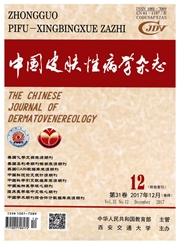

 中文摘要:
中文摘要:
目的探讨Q开关YAG激光及化学脱色法对豚鼠皮肤黑素细胞的影响,从而构建色素脱失动物模型。方法分别应用Q开关YAG激光照射及5%H2O2化学脱色处理豚鼠黑色皮肤,肉眼观察皮肤颜色变化,HE染色和HMIM5免疫组化染色观察皮肤黑素细胞的变化。结果Q开关YAG激光照射3次后,豚鼠黑色皮肤变为白色,同时长出白色毛发,HE及HMIM5染色后基底层未见黑素细胞。2个月后,照射区域皮肤及毛发仍呈白色,镜下基底层亦未见黑素细胞。而化学脱色法可使皮肤略变白,毛发仍呈黑色,HE及HMB45染色镜下基底层仍可见大量黑素细胞。结论Q开关YAG激光可以构建短期稳定色素脱失动物模型,为色素减少性皮肤病的研究提供了可依据的动物模型。
 英文摘要:
英文摘要:
Objective To explore the changes on melanocytes from guinea pig skin which was derived by Q-Switched YAG laser or chemical decolorization and to establish animal models for depigmentation. Methods Q- Switched YAG laser or 5% H202 chemical decolorization was separately applied to guinea pig's dark skin, and then the change of skin color was observed under macroscopy while melanocytes were detected after stained by HE and immunohistochemistry with HMB45. Results After radiated by Q-Switched YAG laser for three times, the dark skins became white and grew white hair, meanwhile melanocytes were not seen in the stratum basale through HE and HMB 45 stain. Two months later, the skins and hair still maintained white and melano- cytes couldn't be seen in the stratum basale. However, chemical decolorization could slightly make darken skins decolored while the hair still appeared black, and melanocytes could be seen obviously after stained with HE and HMB45. Conclusion Compared with chemical decolorization, Q-Switched YAG laser could establish stable animal models for depigmentation temporarily.
 同期刊论文项目
同期刊论文项目
 同项目期刊论文
同项目期刊论文
 期刊信息
期刊信息
